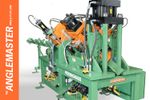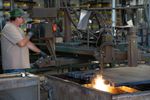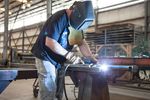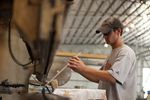An industrial spiral staircase should be no exception to the old adage, “measure twice, cut once,” still in use after 400 years. When precision is paramount, taking the time to confirm specs should be a priority. Smart and thorough planning translates into efficient and high-quality products, while compensating for poorly planned work can be expensive at best, and potentially dangerous at worst.
And when you’re talking about an industrial spiral staircase, there is no room for error — OSHA makes sure of that.
Fabricating an industrial spiral staircase is especially tricky because their fabricator needs to compute vertical curvature to reach specific heights, while also factoring the horizontal curvature to wrap around a tank’s wall.
And an engineer needs to do two sets of calculations, because the inward stringer — the inside part of the staircase upon which the steps (or “treads”) themselves are mounted — has a tighter arc than the outer stringer. Think of a slowly spinning bicycle wheel and how the inner hub and outer tire are parallel, yet require different amounts of material and a different arc to complete a rotation because of the distance being traveled.
OSHA Industrial Spiral Staircase Rules
While it does indeed take an experienced engineer to design a certified industrial spiral staircase, OSHA has a number of spiral staircase code requirements that every project manager or purchasing agent should be aware of and that are simple enough to verify.
1. Step Dimensions
For normal use, an industrial spiral staircase needs its steps to be at least 11 inches wide from the tread center to the outside, and must be 6 inches deep at the midpoint — remember, as the staircase is spiraling, the steps themselves are shaped like a slice of pizza, with the tip pointing toward the center while the “crust” is on the outside; the inner part of the step will be too narrow for ordinary use (thus the spec is measured from the middle, which is the practical edge of the step).
If the industrial spiral staircase will have limited access, the minimum size drops to 9 inches wide and 5 inches deep at the step center.
2. Height Increments
There’s actually some flexibility in the required rise height of the steps, as long as the rise is consistent throughout. Each step must rise between 6.5 inches to 10.5 inches.
3. Weight-Bearing
The minimum load capacity must be at least 100 pounds per square foot, with a minimum tread center concentrated load of at least 300 pounds.
4. Railings
Railings for industrial spiral staircases have their own specific set of OSHA rules. The railings must be capable of withstanding a force of at least 200 pounds applied in every direction, and should stand between 32 inches and 36 inches in height from the tread surface to the upper top rail surface.
For stairways less than 44 inches wide, at least one handrail is required; two handrails are required for stairways between 44 inches and 88 inches wide or when the distance between the tank shell and the stair stringer is greater than 8 inches; and stairways wider than 88 inches require an intermediate handrail so there’s always one in reach (e.g., the handrail in the middle of a wide stairway for those using it away from the edge).
5. Headroom
As the staircase spirals above itself, there needs to be at least 6.5 feet of clearance above the top step.
Getting Industrial Stairs Right the First Time
More often than we would like, we’re called in to fix mistakes made by less experienced “experts” at fabricating industrial stairs. This saddens us because where we come from, you do a job right the first time.
Part of why customers look to us is because we know how complex the fabrication process is, and we don’t underestimate this type of job or cut corners. While we take great pride in fixing problems, we take greater pride in not creating the problems in the first place through careful planning and documentation. We know OSHA's spiral staircase code requirements.
Here at Southern Metal Fabricators, we understand that fixing a problem doesn’t incur just the cost of the fix, but also means lost production. In our book, doing something right the first time is always less expensive. That’s why we’ve created our own version of the reliable saying that has guided engineers and craftsmen for centuries: “Measure twice, cut a check once.”
If you need help correcting an industrial spiral staircase or would like to inquire about having one made right the first time, please contact us or call us at 1.888.421.9661.





